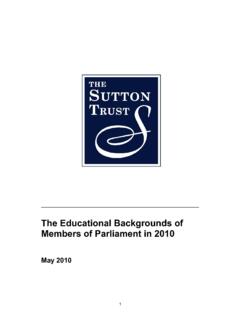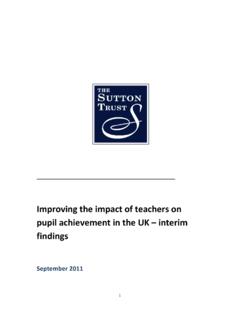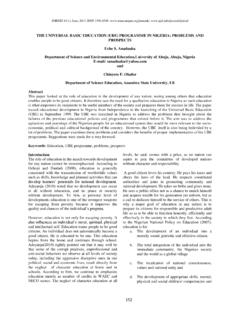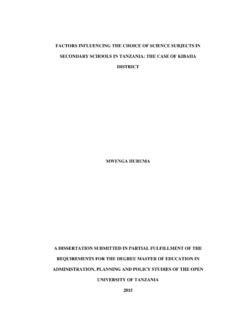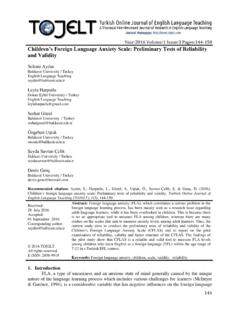Transcription of The Creation, Development and Present State of …
1 1 the creation , Development and Present State of Grammar Schools in England Professor David Jesson University of York Centre for Performance Evaluation and Resource Management University of York York YO10 5DD United Kingdom 2013 David Jesson University of York. 2 1. An historical account of the Development of Grammar schools Competitive Selection for Grammar school education had long been seen as a natural part of the process by which schooling should be organised and scarce resources applied to support the maintenance of an administrative elite. Whilst Grammar Schools have been a feature of the English education system at least since the time of Henry VIII, their emergence as an integral part of a fully-funded State compulsory education system offering Secondary Education for All only arose as a consequence of the 1944 Education Act which enshrined the role of selection as its principal instrument.
2 The idea that each child had a fixed level of 'innate intelligence' which could be measured and presented as an Intelligence Quotient (IQ) score was widely promoted, most notably by psychologist Cyril Burt, who did more than anyone to advocate the widespread use of IQ tests 'for the purpose of pinning permanent labels on schoolchildren at the age of eleven' (Chitty, 2007). Burt provided much of the theory on which the influential Hadow Reports of the 1930 s were based and wielded enormous influence over many years and, through the 1938 Spens Report1 contributed to the structure of the secondary education system that emerged in the wake of the 1944 Education Act2. Early Development of State -funded Grammar schools The Education Act of 1902 had set up Local Education Authorities to provide universal elementary education up to the age of 14 but which could also include the provision of secondary schools for bright children.
3 Secondary education was provided for a minority of able pupils in often newly created Grammar Schools. This was distinct from the elementary education provided for all other State -funded pupils. These Grammar Schools, like their independent counterparts, charged fees for the pupils they educated. However, the Education (Administrative Provisions) Act of 1907 required that all grant-aided secondary schools provide at least 25% of their places as free scholarships to pupils from public elementary schools. Over the period from 1913 to 1937, the proportion of free places in secondary schools rose from around one third to just 1 Ministry of Education (1938) Report of the Consultative Committee on Secondary Education with special reference to Grammar Schools and Technical High Schools London.
4 2 (Gillard D (2008) Us and Them: a history of pupil grouping policies in England's schools see: ) 3 under one half. There were, however, substantial regional differences in provision and take-up and, more importantly, between different social classes. Little and Westergaard s 1964 paper3 showed that over the period from the early 1900 s, whilst overall attendance at Grammar schools almost doubled, children admitted from semi-skilled and unskilled worker parental backgrounds increased from around 1% to 10%. Table : Social Class differentiation in admissions to Grammar schools Father s Occupation Pre 1910 1910 - 19 1920 - 29 1930 - 39 Professional, managerial 37% 47% 52% 62% Other non-manual 7% 13% 16% 20% Semi-skilled or unskilled 1% 4% 7% 10% All 12% 16% 18% 23% Data source: The rate of increase in this period for pupils from the lowest classes was higher than for those from other classes however, the absolute gains were highest for those pupils with Professional and Managerial class parents, where admissions rose from just over one third to almost two thirds.
5 Commenting on this Boudon (1973)4 reported that: From the point of view of individuals, the probability of attending grammar school increased over this period much more rapidly for lower class than for higher class pupils.. But from the point of view of social groups from the beginning to the end of the period under review 100 higher class people have been able to send an additional 25 pupils to Grammar schools whereas this additional number was just 9 for the lower group This issue grew in importance over the next thirty years as the impact of reconstruction after World War II began to impact on society. The changes in structure of education subsequently brought about by the 1944 Education Act had been articulated by The Spens Report 5. This sought to bring a degree of order into what was an increasingly diverse and confusing range of public education provision by setting out a framework for its future Development .
6 Essentially this proposed a tripartite system which provided for universal education within primary and secondary phases, the secondary phase of which was to be tripartite in nature 3 Little, A, and Westergaard, J. (1964) Trends in Class Differentials in Educational Opportunity in England and Wales British Journal of Scociology, 15 1964. 4 Boudon, R. (1973) Education, Opportunity and Social Inequality New York John Wiley 5 Ibid. 4 comprising schools for academic pupils, technical/vocational schools and modern schools for the majority. The type of school a pupil attended was to be appropriate for their age, aptitude and ability and there was to be parity of esteem for each type of school. The full description of, and justification for the tripartite system of secondary education was provided in the Ministry of Education Pamphlet 9 (published in 1947) under the title The New Secondary Education.
7 One remarkable aspect of the processes that led to the 1944 Act was the degree of political consensus about the way that secondary education should be organised. This is not to say that alternative voices were not raised, (mainly critical of the class bias of much of the system prior to 1944 and its contention that this was simply being reinforced by the provisions of the Act). However, from the mid 1940 s to the mid 1960 s, Grammar schools and selection tests for entry ( the 11+ ) provided the key feature of the education of children in England (and Wales). Figure Number of Grammar Schools in existence after the 1944 Act along with the political composition of Government of the day 2010200019901980197019601950194020102000 1990198019701960195019401200100080060040 02000 YearNumber of Grammar SchoolsGrammar School Numbers and Governing Political PartyRed: Labour AdministrationBlue: Tory Administration Data source: Bolton, P.
8 (2013) Grammar School Statistics, House of Commons Library, SN/SG/1398, 20 May 2013. Over a twenty year period the two main political parties administered a system which both created and maintained large numbers of Grammar schools. Immediately following the 1944 Act there were around 1200 State -maintained Grammar schools whilst, at its peak there were just fewer than 1300 in 1965. In practice after the passing of the 1944 Education Act the intention that finding the right school for each child should be uncontroversial was, to a considerable extent, compromised. This was because, although the declared intention was for parity of 5 esteem , Grammar schools with (in many cases) their historical prestige and their necessarily exclusive selection procedures, came to be seen as the destination of choice for children of aspirational families.
9 Inevitably this was at the expense of other, possibly more appropriate, routes. Secondary Modern schools were often only seen as a destination for those who had either failed or not been put in for Grammar school selection tests. Floud, Halsey and Martin s 1953 6 was one of the first analyses of the nature of existing secondary school provision which provided the first of a growing literature of critiques of selective education, identifying some of the factors which militated against working class children gaining access to and succeeding in Grammar schools. Amongst these, articulated by a range of contributors, were concerns: about the fundamental nature of the intelligence on which the selection of pupils was supposed to be based; about the tests themselves which were claimed to be highly susceptible to coaching and training ; about the additional discrimination that appeared to operate to reduce the chances of relatively disadvantaged pupils attaining entry to Grammar schools; and, finally the apparent judgement of failure experienced by those not selected and on those children s subsequent life-chances.
10 These, and other concerns relating to the age of buildings and the need for a major school rebuilding programmes fuelled an active search for alternatives to the tripartite system which was itself relatively politically neutral in its early stages. One other feature which was of growing concern was the polarisation of intakes to Grammar schools away from those from lower class backgrounds. The search for alternatives to selective education Initially this process of withdrawal from a fully selective form of secondary school organisation throughout the 1950 s was sporadic and developed independently of political allegiance. Leicestershire was one of the first LEAs to develop a systematic move towards a more comprehensive admissions policy, where ALL pupils (in the experimental areas) moved from their primary school to their local secondary school at age 11.


